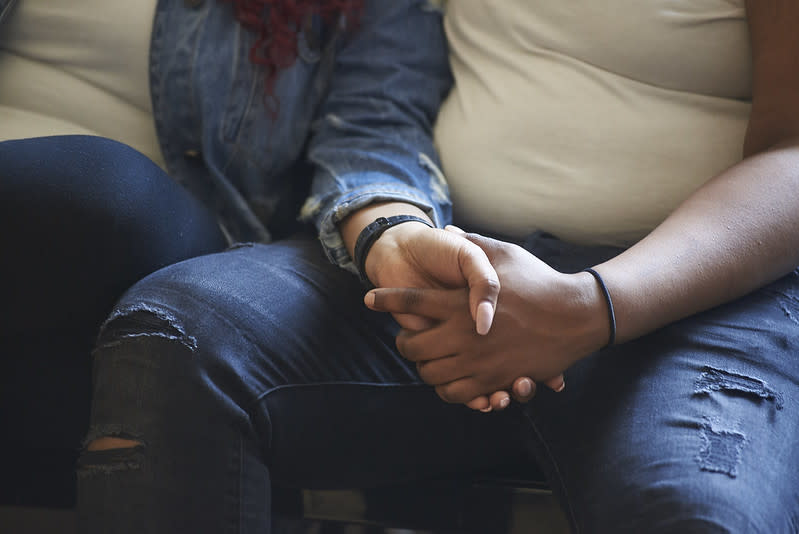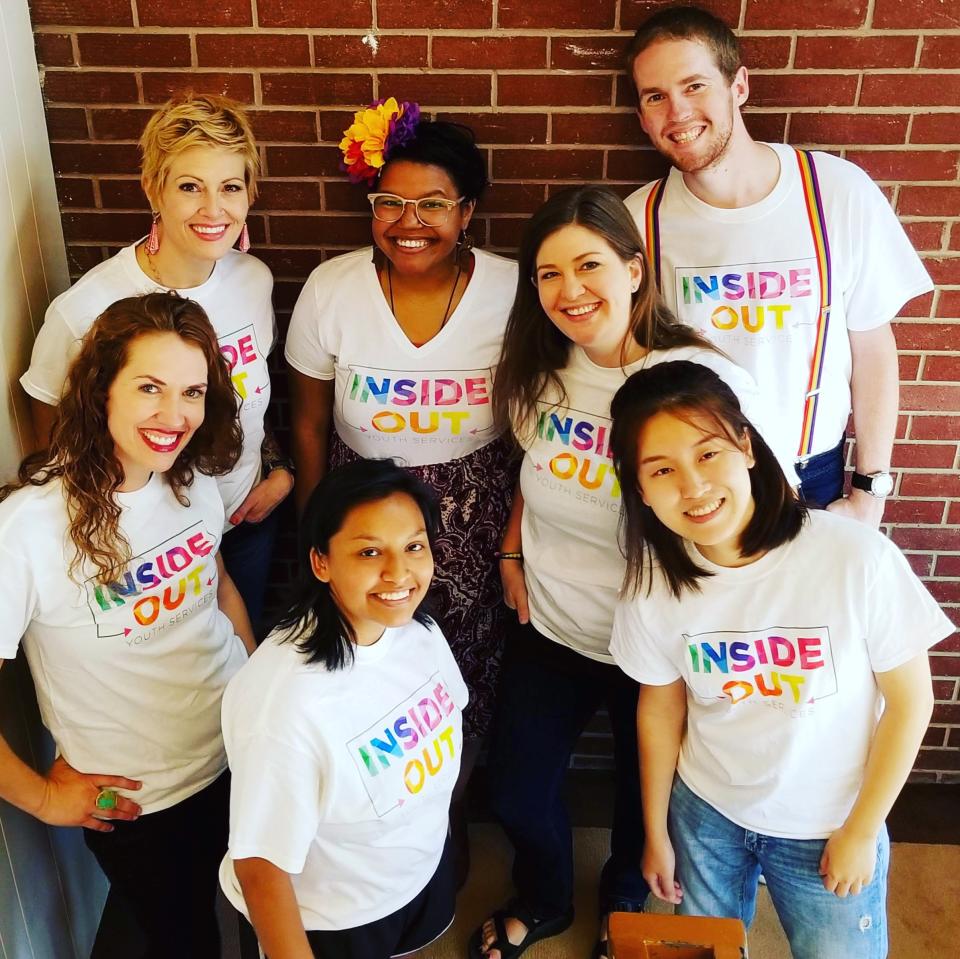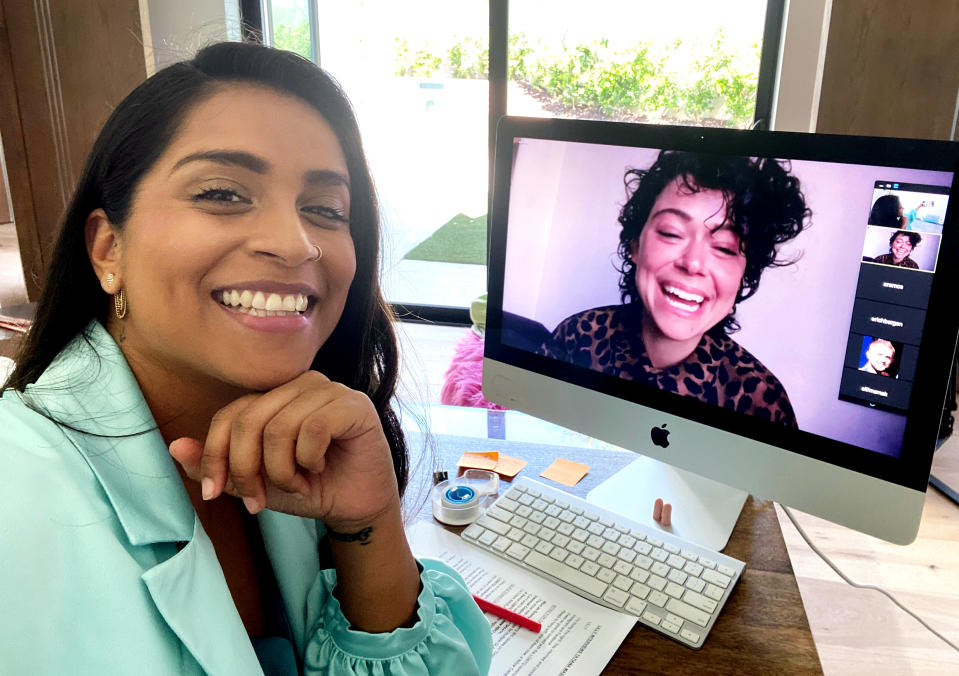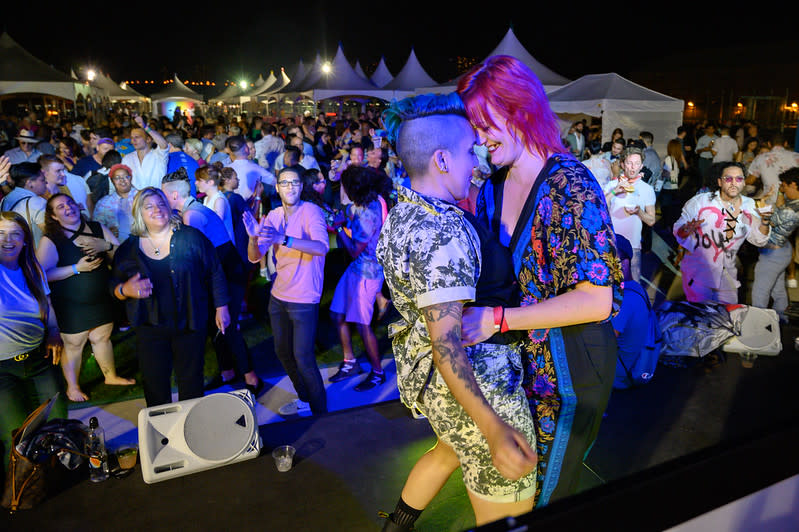Shuttered LGBTQ community centers feel shutdown fallout: 'It's been really hard'

Alyx Irving, 18, first started spending time at Affirmations, an LGBTQ community center in the Detroit suburb of Ferndale, Mich., three years ago, when his gay older brother brought him along. It soon became his second home.
“I’m usually there all the time,” Irving tells Yahoo Life. “It’s a joke between everyone that I actually live there.” It was at the community center and through its support groups that the teen, who identifies as genderqueer, found the acceptance he does not have at home.
“There are a lot of really warmhearted, supportive people, and it’s a place where you can be your authentic self, which is something I don’t have a lot outside of Affirmations,” he says.
But the center closed in March, just like hundreds of others across the country, as part of the coronavirus pandemic. And now, says Irving, a deep loneliness has set in.
“It’s been really hard on me,” he says. “My mental health has kind of been depleting and I don’t have a lot of contact info for the other youth because we hadn’t gotten that close yet. So, it’s been pretty depressing.”
As if the direct fallout of the coronavirus crisis has not been enough — more than 50,000 dead, over 26 million and rising have filed for unemployment as of Tuesday — the collateral damage, too, has been staggering, leaving just about every thread in the fabric of American society, from restaurants and shops to arts and social service nonprofits, at risk of unraveling.
That includes LGBTQ community centers, which provide a wide range of services, not the least of which is a powerful human connection to a population that’s prone to feelings of isolation.

That’s why this week has been dedicated to fundraising efforts for CenterLink, a nonprofit network of over 250 local LGBTQ community centers, including Affirmations, across the nation and in Canada, China, Mexico and Australia. It kicked off on Sunday night with the star-studded live stream, Together in Pride: You are Not Alone, produced by GLAAD, and culminates on May 1, with a 20th anniversary Queer as Folk reunion event.
Video: Stars Unite For Livestream to Support LGBTQ Community Centers
“I know this is a really scary time for everyone — and it can be especially isolating for queer people who are away from their chosen families and support systems,” said Billy Porter, appearing early in the 90-minute patchwork of performances and interviews, wearing oversized, sparkly, asymmetrical glasses. “Because of the COVID-19 crisis, so many of the smaller local LGBTQ centers and organizations that embrace and support the queer community are in danger of closing. But tonight, we are coming together to try to stop that from happening.”
Sunday’s event, hosted by Billy Eichner and Lilly Singh, with performances and messages of support from luminaries including Barbra Streisand, Jonathan Van Ness, and the cast of Jagged Little Pill, raised over $225,000 for CenterLink, which laid out the dire financial situation in a letter to the U.S. House and Senate earlier this month.
The cast of @jaggedmusical blew us away with their performance on #TogetherInPride pic.twitter.com/YccHYyZNUD
— GLAAD (@glaad) April 27, 2020
In that letter, the LGBTQ community centers made a plea to be included in future stimulus packages as they provide “critical services such as medical care, mental health counseling, virtual support groups, filling prescriptions, providing hot meals and check-in phone calls for older adults, serving as shelters for homeless youth, distributing non-perishable food items and hygiene products, case management, HIV testing, and hosting virtual engagement activities to decrease social isolation.”
The letter warned that “Given the current financial crisis and loss of revenue, LGBT community centers could be forced to shrink their services, meaning tens of thousands could go without care.”
Gay community centers are often a lifeblood for queer people, particularly youth who are new to being out and living in vulnerable situations — in unaccepting or abusive households, or even in shelters or on the streets — and who tend to be more at risk of suicide. While suicide is the second leading cause of death for youth ages 10 to 24, gay and lesbian youth are almost five times as likely to have attempted suicide than heterosexual youth; further, the Trevor Project notes, of the 40 percent of transgender adults who report having made a suicide attempt, 92 percent made the attempt before the age of 25.

Now that LGBTQ centers are closed, hopefully temporarily, and despite the fact that many have brought their support services to video platforms, directors are worried about what the future will bring to the clients who rely on them for vital services.
“One of biggest things that’s been so hard is one out of three [of our clients] was experiencing homelessness, and we have zero connection to them right now,” says Jessie Pocock, executive director of Inside Out Youth Services in Colorado Springs, Colo., which serves clients ages 13 to 22 and saw up to 50 kids enter their doors each day before closing. “They have no cellphones, they’re living in camps or on the streets. They would come for the food pantry, for clean clothes every day, and they would connect with each other. The hardest thing for us has been figuring out, how do we get them support when we aren’t open?”
Pocock tells Yahoo Life that El Paso County, where the 30-year-old center is located, “has one of the highest youth suicide rates in the nation and that it is the leading cause of death for young people ages 10 to 17.” What makes this particularly difficult, she adds, is that “LGBTQ youth are three times as likely to seriously consider suicide in Colorado. Our work is literally lifesaving for these young people.”

That’s also true when it comes to helping youth who face abuse at home — a situation that would prompt social workers to make around eight mandatory reports weekly before closing, while they now are only making one to two, which is a reflection of fewer youths sharing that they are in need of help.
“When you’re in person, face-to-face, you’re building trust and relationships,” she says. “Now, because we don’t have young people in person, they’re not coming, or we’re not identifying it. That’s one of the major things.” The center’s financial future is also hanging in the balance; much of its work has been powered by state grants, Pocock says, but now the department that had allocated to them has been tasked with one mission only: pandemic response.
“There’s been talk of catastrophic loss of state funding for the next year. And so many programs are tied to it,” she says. “And it’s not like COVID happened and our services became unnecessary. … The need has actually doubled, and our staff is working overtime to try to figure out how to provide support. We have been the trusted go-to for all these years.”

At Affirmations in Michigan, which sees 35,000 unique visitors come through its doors each year, executive director David Garcia has very similar concerns. “My worry is all the youth that are couch-surfing or don’t have homes to go to, or are at homes that are homophobic,” he tells Yahoo Life, adding that most people have no idea of the breadth of community services provided.
“There’s HIV testing, mental health therapists, support groups, 12-step meetings — you can go to special events in our 17,000-square-foot space with two pianos, or in our huge art gallery … and when there is an Orlando shooting, for example, we have 500 people show up who just need to be together,” he says, noting that town hall-style meetings have seen the governor, attorney general, secretary of state and county executives appear for the community.
“We have educational events, there’s a rec room so families can come in with their kids and play air hockey and pool. We have queer drag readings for kids — so many different things going on on a daily basis, and you can just come in and be yourself … feel the security of being around a group of like-minded people.” And seniors, he adds, “are the largest single group that meets consistently, for the senior coffee klatch.”

Its major gala, which was to have happened on Apr. 18, was rescheduled to take place on Halloween, though even that feels shaky. And its biggest grants come from the big three in Detroit — GM, Ford and Fiat-Chrysler — but now, Garcia says, “Everything’s on hold. So it’s a cash-flow problem.” To make up for shortfalls right now, he says, the organization has shifted some grants and private donations to services such as providing grocery delivery to seniors.
In New York City, meanwhile, home to the biggest LGBTQ community center after that of Los Angeles, there are typically 6,000 unique individuals coming through weekly — 300,000 over an entire year. That’s a lot of people being left in the lurch right now.
“We work with folks across the age spectrum, with programs designed to reach highly vulnerable populations — for example, 65 percent identify as people of color, while a quarter are transgender or gender nonconforming … with a disproportionate number of young people, 40 percent, unstably housed,” Jeff Klein, COO of the Center, tells Yahoo Life.
“The isolation folks feel, especially when you’re new in the coming-out process, can be very traumatic. So, we’re trying to be available for young people, given limitations, with virtual office hours with our youth staff, our normally five to six groups a day now moved to virtual, so they can generally connect to community,” he says, explaining that they’d never offered telehealth before the shutdown. “Community is the antidote to isolation, which affects the queer community rather uniquely, having felt isolated at various points in our lives, and [this situation] can exacerbate it.”
Fundraising has also been affected, Klein explains, as the Center had to cancel its annual fundraising dinner and garden party, usually held to kick off Pride week in June. “The community has been fantastic, in terms of expressing their support and donating, but not anywhere near what the impact demands,” Klein says, adding that the Center announced this week a foundation challenge, which will match the first $100,000 received by donors.
Still, say community center directors, if there has been any upside to the closures, it’s that taking its support groups and 12-step meetings and therapy sessions online has significantly expanded their reach.
Says Joseph Shelton, youth program assistant with Inside Out Youth Services, “A lot of people may not be out to their families, and didn’t have the safety of saying, ‘Hey, I want to go to Inside Out,’ so now they have the plus of being able to log on online. We have had an influx of youth who hadn’t attended the physical space and are now logging on. So definitely it’s opened up the capacity to bring more people into our space.”
Similarly, in New York City, the number of one-on-one counseling sessions was able to be increased 40 percent as of the second week after the building had closed. That’s thanks to therapists having a different mix of services than before, Klein says, and being able to add more session time. For that, he says, “The messages we’ve been receiving from folks … have been of immense gratitude, and that our community is resilient, and has faced incredible challenges before.”
At Affirmations, the first closed week brought an uptick in people joining AA and NA groups, Garcia says — up from the usual 25 people to over 85 “from a lot of rural areas of Michigan and as far away as Sweden and Scotland.” Then the Zoom sessions began to get hacked, which brought about an adjustment period with tightened security, but attendance has remained higher than before, at about 40 per meeting.
“We’re never going to go back the way that it was,” Garcia says. “And even if we do go back to normal, every group will now have a video component, because we’ve seen the silver lining.”
For the latest coronavirus news and updates, follow along at https://news.yahoo.com/coronavirus. According to experts, people over 60 and those who are immunocompromised continue to be the most at risk. If you have questions, please reference the CDC’s and WHO’s resource guides.
How to maintain your physical and mental health during the pandemic
Taking care of a loved one with COVID-19? Here’s how to stay healthy
Q&A with Dr. Kavita Patel: How to keep your family safe and maintain your mental health
Read more from Yahoo Life
An expert reveals how to fight off loneliness while quarantining alone
What is 'quarantine fatigue' and what can you do to fight it?
How fostering an animal during coronavirus pandemic could cause a surge in 'love hormones'
Want daily lifestyle and wellness news delivered to your inbox? Sign up here for Yahoo Life’s newsletter.



